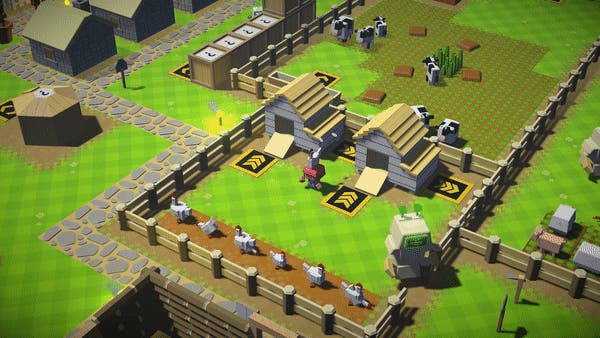Autonauts is a game about how robots are only as clever as their creator
And that's you.
Autonauts starts simply enough. Craft a bot, train it to chop down a tree, watch it trundle off to do your bidding. What could go wrong? Well, it turns out, quite a lot - because these robots are only as smart as you tell them to be.
"We had something like this the other day," creator Gary Penn tells me. "The Scunthorpe problem." You can teach a machine how to do something and it will do it to the letter - without human intuition to stop when necessary. In the most recent case, it was developer Denki's own profanity filter used to double check the names players give to Autonauts bots. Such systems are notorious for deciding certain clusters of letters - such as those in the name of that particular North Lincolnshire town - are enough to set their ones and zeroes flashing.
But Penn is a veteran of dealing with such things. Starting as a games journalist, he later worked at DMA Design, the studio which would become Rockstar, making Grand Theft Auto and Lemmings - perhaps the closest game to Autonauts on his CV. After that, he helped found Denki, the team behind the Xbox 360 and mobile puzzler Quarrel - a brilliant kind of Scrabble meets Risk. That game hit the Scunthorpe problem, too.

"Xbox has its own lists," Penn says, recalling the day Microsoft's swear filter encountered Quarrel's 130,000-word in-built Scrabble dictionary. "Cock, for example," Penn recalls. "Well, we said, cock doesn't have to mean penis. And we're providing a definition, so surely that's fine. 'OK,' they said. 'But you can't have train.' Train?! What the fuck? We can't not have train. Apparently it's a sex act. I hadn't heard of it.
"Balls was on their list, though ball was fine." Penn sighs. "It was a word game! We discussed things with them and, in the end, we got most stuff in. Balls got in. So did train."
I'm sat with Penn at Gamescom as he whizzes around various Autonaut builds, showing me progressively more complicated systems constructed after more time with the game. We've now fast forwarded around 10 hours and it is absolutely no longer about teaching robots to chop down trees.
Hundreds of bots now zip about, a busy network to turn that tree you chopped down into wood to craft tools to build a farm which rears sheep to shear wool to make clothes you can wear while teaching your latest bot to do something else.
The game's eventual win state will see your colony's human population become astral beings, Penn says, while still showing me tools from the pre-industrial era. It's increasingly dizzying stuff, but even with a screen full of activity, Autonauts' basic idea remains. Anything you can do in the game, the robots can copy. So, in other words, the idea is to do as little as possible.
Examine an individual Autonauts bot's programming - because there is a kind of coding language you see when you peer into their brains - and you will see the tasks it has been assigned: Go here, pick up this, if there's space to build another tool, go do that. The trick is making sure this basic stuff works with everything else.
If it all sounds daunting, then rest assured you can take Autonauts as slowly as you please, and colonising a planet with your robots is meant to be a relaxing venture. Each procedurally generated map has enough resources to succeed, and there are no fail states. If something goes wrong, your robots simply pause - nothing blows up, no one dies, and there are no obvious timers for you to sit worrying about.
Land on a planet and hit some resources with your shovel, and you'll have set up a workbench to build stone tools and robot parts. Show your robot to go looking for trees in a particular grid area, move to it, then use whatever you're holding to chop it down. The robot will then copy that until it has either run out of trees, the axe breaks, or it runs out of power.
Fast forward to 90 minutes, and you have robots planting tree seeds, creating new tools, handing them over, recharging other robots, and so forth. Each can be colour coded or given skins or names (yes, including 'train') to customise their appearance. You can develop clever little programs, so a robot will notice when a tool has been taken from the tool storage and use that as its prompt to then begin making another.
This is, of course, all in service of a growing human population. These humans initially have simple needs (food to eat, shelter to sit in) and when met, they generate love. Love can then be turned into research for new technology.
10 to 12 hours in, the humans have grown - physically, they're now huge, and they require a more balanced diet. They need better food, distractions, toys and other things, and by now you can make the map resemble a proper town, with roads and structures housing all your trusty bots as they beaver away.
Penn's showing me his kitchen, where berries from a farm can combine with spices over a fire made using wooden sticks and stones. You also need a cooking pot, he says, which needs clay from a mine. And a potter's wheel. And a kiln. It's never ending. But then so is your army of robots. You just need to keep them all in check.


